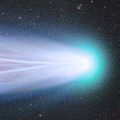
|
It brightened up to 3 mag in outburst on Dec. 14. Then several small outbursts occured repeatedly, and the comet has been fading gradually. But it is bright as 8.5 mag still now (Jan. 28, Chris Wyatt). In the Southern Hemisphere, it becomes unobservable temporarily in early February. But it will appear in the morning sky in mid February. In the Northern Hemisphere, it will become observable again at 13 mag in late April.
Date(TT) R.A. (2000) Decl. Delta r Elong. m1 Best Time(A, h)
Jan. 29 21 35.93 -36 5.7 1.660 0.824 21 8.8 18:52 ( 58,-18)
Feb. 5 21 32.64 -35 47.0 1.783 0.922 20 9.4 18:58 ( 62,-24)
|
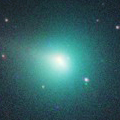
|
Now it is bright as 8.9 mag (Jan. 28, Chris Wyatt). It stays bright as 9-10 mag until March. In the Northern Hemisphere, it stays observable in excellent condition for a long time. In the Southern Hemisphere, it will be extremely low in February.
Date(TT) R.A. (2000) Decl. Delta r Elong. m1 Best Time(A, h)
Jan. 29 1 18.62 2 5.4 1.253 1.307 70 8.9 18:52 ( 49, 46)
Feb. 5 1 35.67 7 4.4 1.283 1.307 68 8.9 18:58 ( 58, 47)
|
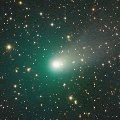
|
Now it is 9.4 mag (Jan. 28, Chris Wyatt). It stays bright as 10 mag until spring for a long time. It stays observable in good condition for a long time. It locates somewhat low in the Southern Hemisphere,
Date(TT) R.A. (2000) Decl. Delta r Elong. m1 Best Time(A, h)
Jan. 29 6 46.34 27 23.0 2.664 3.559 151 9.9 22:12 ( 0, 82)
Feb. 5 6 41.72 25 56.9 2.722 3.563 143 10.0 21:40 ( 0, 81)
|
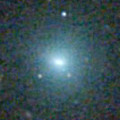
|
Brightened very rapidly. Now it is very bright as 9.8 mag (Jan. 28, Chris Wyatt). It is observable at 10 mag in good condition until February.
Date(TT) R.A. (2000) Decl. Delta r Elong. m1 Best Time(A, h)
Jan. 29 2 7.31 3 17.1 0.639 1.098 82 10.3 18:52 ( 34, 54)
Feb. 5 2 42.53 5 42.2 0.644 1.122 84 10.5 18:58 ( 35, 56)
|
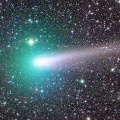
|
Now it is very bright as 10.3 mag (Jan. 24, Charles S. Morris). It stays observable in good condition for a long time. It locates somewhat low in the Southern Hemisphere,
Date(TT) R.A. (2000) Decl. Delta r Elong. m1 Best Time(A, h)
Jan. 29 8 33.25 29 0.8 0.632 1.609 168 10.3 0:03 ( 0, 84)
Feb. 5 8 27.99 28 41.4 0.692 1.661 163 10.7 23:26 ( 0, 84)
|
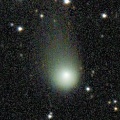
|
Now it is bright as 11.7 mag (Jan. 27, Osamu Miyazaki). It is expected to be observable at 5-6 mag for a long time from 2022 to 2023. In the Northern Hemisphere, it stays observable in good condition until autumn. However, it is not observable at the high light from autumn to 2023 summer. In the Southern Hemisphere, it will be observable after February. Then it will be observable in good condition at the high light.
Date(TT) R.A. (2000) Decl. Delta r Elong. m1 Best Time(A, h)
Jan. 29 18 19.91 11 47.4 4.759 4.144 46 10.6 5:34 (275, 28)
Feb. 5 18 25.19 11 35.1 4.645 4.081 49 10.4 5:29 (278, 32)
|
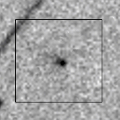
|
In the Northern Hemisphere, it stays extremely low until spring. In the Southern Hemisphere, it stays observable at 11 mag until June.
Date(TT) R.A. (2000) Decl. Delta r Elong. m1 Best Time(A, h)
Jan. 29 18 18.89 -20 58.6 2.342 1.627 34 11.6 5:34 (303, 8)
Feb. 5 18 41.65 -20 50.9 2.294 1.608 36 11.4 5:29 (303, 8)
|
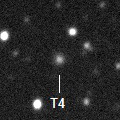
|
Now it is 12.6 mag (Jan. 21, Ken-ichi Kadota). It will brighten up to 11.5 mag in spring. It stas observable in good condition for a long time.
Date(TT) R.A. (2000) Decl. Delta r Elong. m1 Best Time(A, h)
Jan. 29 12 8.06 -29 30.6 3.920 4.380 111 12.0 3:37 ( 0, 25)
Feb. 5 12 8.09 -29 13.1 3.814 4.366 118 11.9 3:09 ( 0, 26)
|
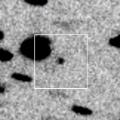
|
Now it is 14.9 mag (Jan. 4, Ken-ichi Kadota). It will brighten up to 12 mag from winter to spring.
Date(TT) R.A. (2000) Decl. Delta r Elong. m1 Best Time(A, h)
Jan. 29 17 2.00 -19 34.8 1.976 1.582 52 12.4 5:34 (315, 21)
Feb. 5 17 24.18 -20 32.4 1.924 1.569 54 12.3 5:29 (316, 21)
|
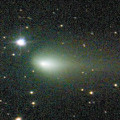
|
It brightened up to 10.6 mag in autumn (Oct. 10, Osamu Miyazaki). Now it is fading. But it is still bright as 11.7 mag (Jan. 24, Osamu Miyazaki). It stays observable in good condition for a long time.
Date(TT) R.A. (2000) Decl. Delta r Elong. m1 Best Time(A, h)
Jan. 29 6 20.35 9 46.3 1.256 2.134 144 12.9 21:46 ( 0, 65)
Feb. 5 6 20.32 10 29.3 1.342 2.175 137 13.2 21:19 ( 0, 66)
|

|
Now it is bright as 11.1 mag (Jan. 24, Charles S. Morris). It has a large diffuse coma.
Date(TT) R.A. (2000) Decl. Delta r Elong. m1 Best Time(A, h)
Jan. 29 4 15.63 30 1.4 5.423 5.953 118 13.5 19:42 ( 0, 85)
Feb. 5 4 15.64 29 48.8 5.527 5.955 111 13.5 19:14 ( 0, 85)
|

|
Now it is 15.1 mag (Dec. 14, Chris Wyatt). It will brighten up to 13 mag in spring. In the Southern Hemisphere, it stays observable in good condition for a long time. In the Northern Hemisphere, it is not observable until autumn.
Date(TT) R.A. (2000) Decl. Delta r Elong. m1 Best Time(A, h)
Jan. 29 12 7.32 -63 30.4 3.273 3.409 89 13.9 3:37 ( 0, -9)
Feb. 5 11 45.64 -65 58.6 3.183 3.384 93 13.8 2:48 ( 0,-11)
|

|
It brightened up to 12.3 mag from spring to summer (June 15, Marco Goiato). Now it is fading. It has already faded down to 14.2 mag (Jan. 15, Ken-ichi Kadota).
Date(TT) R.A. (2000) Decl. Delta r Elong. m1 Best Time(A, h)
Jan. 29 14 24.80 9 43.6 4.012 4.257 97 14.0 5:34 (349, 64)
Feb. 5 14 21.67 11 24.9 3.928 4.295 105 14.0 5:22 ( 0, 66)
|
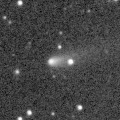
|
Now it is 14.5 mag (Jan. 12, Michael Jager). It will brighten rapidly, and it will be observable at 13.5 mag in good condition from winter to spring.
Date(TT) R.A. (2000) Decl. Delta r Elong. m1 Best Time(A, h)
Jan. 29 10 0.96 17 38.6 1.528 2.483 161 14.3 1:30 ( 0, 73)
Feb. 5 9 56.06 18 4.4 1.486 2.462 169 14.1 0:58 ( 0, 73)
|
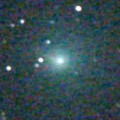
|
It brightened up to 9.8 mag from autumn to winter (Nov. 22, Thomas Lehmann). Now it is fading. It has already faded down to 14.4 mag (Jan. 24, Charles S. Morris). It will be fainter than 18 mag in March.
Date(TT) R.A. (2000) Decl. Delta r Elong. m1 Best Time(A, h)
Jan. 29 1 0.35 -11 45.6 2.242 1.977 61 14.3 18:52 ( 43, 32)
Feb. 5 1 15.04 -9 56.5 2.349 2.026 59 14.9 18:58 ( 49, 31)
|
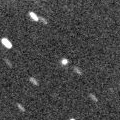
|
Now it is 15.5 mag (Jan. 22, Ken-ichi Kadota). It is expected to brighten very rapidly up to 4.5 mag in April. However, it is not observable at the high light. In the Northern Hemisphere, it stays observable until early February when it brightens up to 14 mag. Then it will appear at 6 mag in mid May, and it stays observable in good condition after that while the comet will be fading. In the Southern Hemisphere, it is not observable until August.
Date(TT) R.A. (2000) Decl. Delta r Elong. m1 Best Time(A, h)
Jan. 29 22 46.71 0 53.9 2.544 1.834 35 14.7 18:52 ( 79, 17)
Feb. 5 22 56.93 0 33.3 2.491 1.717 30 14.3 18:58 ( 82, 12)
|
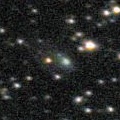
|
Now it is 14.9 mag (Nov. 28, Thomas Lehmann). It is expected to brighten up to 11 mag from spring to summer. In the Southen Hemisphere, it is not observable until February, but it stays observable in good condition for a long time after that. In the Northern Hemisphere, it is hardly observable after this.
Date(TT) R.A. (2000) Decl. Delta r Elong. m1 Best Time(A, h)
Jan. 29 19 42.58 -11 52.3 3.372 2.442 16 14.5 5:34 (283, -2)
Feb. 5 19 49.56 -13 1.9 3.284 2.386 20 14.4 5:29 (286, 0)
|
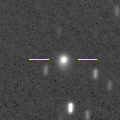
|
Now it is 14.7 mag (Jan. 14, Thomas Lehmann). It is expected to brighten up to 10 mag in 2023. In the Northern Hemisphere, it stays observable in good condition until 2023 autumn. In the Southern Hemipshere, it locates extremely low from January to February. Then it stays unobservable until 2023 summer.
Date(TT) R.A. (2000) Decl. Delta r Elong. m1 Best Time(A, h)
Jan. 29 13 1.17 47 51.2 4.701 5.271 120 14.6 4:30 (180, 77)
Feb. 5 12 56.82 49 41.1 4.598 5.214 124 14.5 3:58 (180, 75)
|
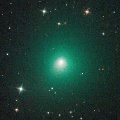
|
It brightened up to 9.5 mag in early summer (June 27, Marco Goiato). Now it is fading. It has faded down to 12.7 mag in autumn (Nov. 22, Thomas Lehmann). Now it is not observable. In the Southern Hemisphere, it will appear in the morning sky at 15 mag in late February. In the Northern Hemisphere, it is not observable until June when the comet will fade down to 17 mag.
Date(TT) R.A. (2000) Decl. Delta r Elong. m1 Best Time(A, h)
Jan. 29 20 35.44 -32 48.1 4.034 3.093 14 14.6 5:34 (294,-24)
Feb. 5 20 48.48 -32 34.1 4.076 3.149 17 14.8 5:29 (295,-22)
|
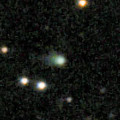
|
Now it is 15.0 mag (Jan. 14, Ken-ichi Kadota). It is expected to brighten up to 11 mag in 2023. In the Northern Hemisphere, it stays observable in good condition for a long time. It is not observable in the Southern Hemisphere.
Date(TT) R.A. (2000) Decl. Delta r Elong. m1 Best Time(A, h)
Jan. 29 16 42.50 32 32.9 5.316 5.182 76 14.8 5:34 (263, 58)
Feb. 5 16 42.92 33 12.3 5.201 5.141 81 14.7 5:29 (264, 62)
|

|
Now it is 15.8 mag (Oct. 4, Thomas Lehmann). Appearing in the morning. It will brighten up to 13 mag in summer.
Date(TT) R.A. (2000) Decl. Delta r Elong. m1 Best Time(A, h)
Jan. 29 17 25.89 -24 31.2 3.736 3.140 46 14.8 5:34 (314, 14)
Feb. 5 17 36.43 -24 50.5 3.654 3.132 51 14.7 5:29 (317, 15)
|

|
Now it is 15.9 mag (Jan. 2, Thomas Lehmann). It will brighten up to 12.5 mag in summer. In the Southern Hemisphere, it stays observable in excellent condition for a long time. In the Northern Hemisphere, it is not observable until August.
Date(TT) R.A. (2000) Decl. Delta r Elong. m1 Best Time(A, h)
Jan. 29 22 22.46 -59 39.2 4.346 3.717 45 14.9 18:52 ( 32,-23)
Feb. 5 22 24.97 -58 33.9 4.315 3.678 44 14.8 18:58 ( 35,-26)
|
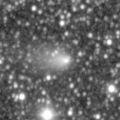
|
It brightened up to 11.5 mag in outburst in October (Oct. 22, Marco Goiato). Now it is fading. It has already faded down to 14.1 mag (Jan. 1, J.-G. Bosch, F. Kugel, J. Nicolas). In the Southern Hemisphere, it is already unobservable. In the Northern Hemisphere, it stays observable until early February.
Date(TT) R.A. (2000) Decl. Delta r Elong. m1 Best Time(A, h)
Jan. 29 22 44.33 -7 27.9 2.737 1.960 30 14.9 18:52 ( 72, 12)
Feb. 5 23 0.51 -5 55.3 2.803 1.989 28 15.2 18:58 ( 76, 9)
|
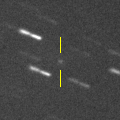
|
Now it is bright as 13.8 mag (Jan. 18, Ken-ichi Kadota. Cometary activity was detected. In the Northern Hemisphere, it is observable only until early March. In the Southern Hemisphere, it is not observable until late May. But it will be observable in good condition after that.
Date(TT) R.A. (2000) Decl. Delta r Elong. m1 Best Time(A, h)
Jan. 29 18 24.84 45 59.9 1.484 1.497 71 15.2 5:34 (236, 41)
Feb. 5 19 20.53 48 13.0 1.432 1.418 69 14.9 5:29 (232, 36)
|

|
Now it is 15.9 mag (Oct. 8, Thomas Lehmann). It stays at 14-15 mag for a long time from 2021 to 2022. In the Southern Hemisphere, it stays observable in excellent condition for a long time. In the Northern Hemiphere, it locates extremely low in spring.
Date(TT) R.A. (2000) Decl. Delta r Elong. m1 Best Time(A, h)
Jan. 29 17 15.18 -32 37.1 5.629 5.038 49 15.3 5:34 (321, 9)
Feb. 5 17 17.48 -33 34.1 5.537 5.045 55 15.2 5:29 (325, 11)
|
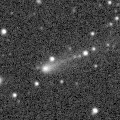
|
It brightened rapidly. Now it is 14.7 mag (Jan. 11, Michael Jager). It stays 15 mag until February, and it is observable in excellent condition.
Date(TT) R.A. (2000) Decl. Delta r Elong. m1 Best Time(A, h)
Jan. 29 8 9.17 14 27.6 1.558 2.535 170 15.3 23:34 ( 0, 69)
Feb. 5 8 3.48 14 13.3 1.587 2.546 163 15.4 23:01 ( 0, 69)
|
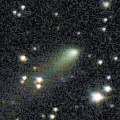
|
Now it is 15.6 mag (Jan. 7, Toshihiko Ikemura, Hirohisa Sato). It will be fading after this. In the Northern Hemisphere, it stays observable in good condition for a long time. It locates low in the Southern Hemisphere.
Date(TT) R.A. (2000) Decl. Delta r Elong. m1 Best Time(A, h)
Jan. 29 16 4.32 25 57.6 2.637 2.668 81 15.4 5:34 (282, 63)
Feb. 5 15 58.51 28 4.8 2.556 2.706 87 15.4 5:29 (284, 70)
|
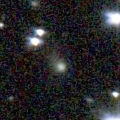
|
Now it is 15.8 mag (Jan. 14, Thomas Lehmann). It is expected to brighten up to 11 mag in 2023. In the Northern Hemisphere, it stays observable in good condition until November. But it becomes unobservable after that. In the Southern Hemisphere, it is not observable until February. But it will be observable in good condition at the high light.
Date(TT) R.A. (2000) Decl. Delta r Elong. m1 Best Time(A, h)
Jan. 29 18 35.63 17 29.8 5.892 5.280 47 15.5 5:34 (268, 28)
Feb. 5 18 40.01 17 22.3 5.804 5.232 50 15.4 5:29 (270, 32)
|
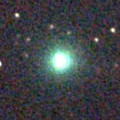
|
It brightened very rapidly, and brightened up to 8.9 mag (Sept. 11, Chris Wyatt). Now it is fading. It has already faded down to 15.7 mag (Dec. 7, E. Cortes, N. Paul, B. Lutkenhoner). In the Southern Hemisphere, it stays observable after this while the comet will be fading. It is not observable after this in the Northern Hemisphere.
Date(TT) R.A. (2000) Decl. Delta r Elong. m1 Best Time(A, h)
Jan. 29 17 4.23 -54 34.1 2.724 2.312 55 15.4 5:34 (336, -8)
Feb. 5 17 17.22 -54 47.0 2.730 2.382 59 15.7 5:29 (337, -7)
|
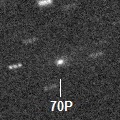
|
Now it is 15.8 mag (Jan. 27, Toshihiko Ikemura, Hirohisa Sato). It stays 15.5 mag until March, and it is observable in excellent condition.
Date(TT) R.A. (2000) Decl. Delta r Elong. m1 Best Time(A, h)
Jan. 29 11 53.73 7 32.9 1.332 2.128 132 15.7 3:22 ( 0, 62)
Feb. 5 11 54.22 8 10.3 1.297 2.147 139 15.7 2:55 ( 0, 63)
|
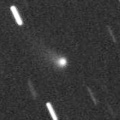
|
Now it is 15.3 mag (Jan. 27, Toshihiko Ikemura, Hirohisa Sato). It stays observable at 15-16 mag for a long time.
Date(TT) R.A. (2000) Decl. Delta r Elong. m1 Best Time(A, h)
Jan. 29 12 55.03 12 20.6 2.804 3.400 119 15.7 4:24 ( 0, 67)
Feb. 5 12 46.24 11 56.9 2.732 3.432 128 15.7 3:47 ( 0, 67)
|
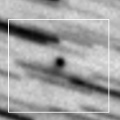
|
Now it is 16.0 mag (Dec. 28, D. Buczynski). It is expected to brighten up to 11 mag in summer. In the Northern Hemisphere, it stays observable in good condition until June when it brightens up to 11 mag. But it is not observable after the high light. In the Souther Hemisphere, it is not observable until October.
Date(TT) R.A. (2000) Decl. Delta r Elong. m1 Best Time(A, h)
Jan. 29 23 7.06 50 54.1 2.920 2.842 75 15.9 18:52 (130, 42)
Feb. 5 23 17.04 50 55.5 2.898 2.763 72 15.7 18:58 (131, 38)
|
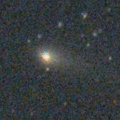
|
It brightened up to 13.1 mag in autumn (Oct. 28, Toshihiko Ikemura, Hirohisa Sato). Now it is fading. It has already faded down to 16.1 mag (Jan. 21, Charles S. Morris). It stays observable in good condition for a long time. But it will be fainter than 18 mag in March.
Date(TT) R.A. (2000) Decl. Delta r Elong. m1 Best Time(A, h)
Jan. 29 2 32.51 8 29.0 1.572 1.852 89 15.9 18:52 ( 27, 61)
Feb. 5 2 46.88 9 48.8 1.662 1.880 86 16.2 18:58 ( 37, 60)
|
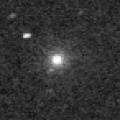
|
It was observed at 9-10 mag from late July to early August. Although it had been unobservable for a long time, it is appearing in the morning sky now.
Date(TT) R.A. (2000) Decl. Delta r Elong. m1 Best Time(A, h)
Jan. 29 16 24.48 -25 48.4 3.129 2.775 60 15.9 5:34 (327, 21)
Feb. 5 16 30.15 -26 37.0 3.117 2.862 65 16.0 5:29 (331, 22)
|
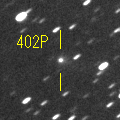
|
First return of a new periodic comet observed at 16 mag from 2003 to 2004. Now it is 16.1 mag (Jan. 3, Toshihiko Ikemura, Hirohisa Sato). It stays 16 mag until March, and it stays observable in excellent condition.
Date(TT) R.A. (2000) Decl. Delta r Elong. m1 Best Time(A, h)
Jan. 29 6 3.75 6 49.4 3.148 3.947 139 15.9 21:29 ( 0, 62)
Feb. 5 6 1.79 7 47.6 3.215 3.949 132 16.0 21:00 ( 0, 63)
|
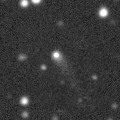
|
Now it is 16.3 mag (Jan. 7, Toshihiko Ikemura, Hirohisa Sato). It stays observable at 16 mag from 2021 to 2022. Appearing in the morning sky also in the Southern Hemisphere.
Date(TT) R.A. (2000) Decl. Delta r Elong. m1 Best Time(A, h)
Jan. 29 16 3.75 14 47.3 4.929 4.798 76 16.2 5:34 (300, 57)
Feb. 5 16 7.90 16 15.1 4.847 4.809 81 16.2 5:29 (304, 61)
|

|
Now it is 16.5 mag (Dec. 19, E. Cortes, B. Lutkenhoner). It will be fading slowly after this. In the Southern Hemisphere, it stays observable in good condition for a long time. In the Northern Hemisphere, it is not observable until July.
Date(TT) R.A. (2000) Decl. Delta r Elong. m1 Best Time(A, h)
Jan. 29 23 47.33 -46 47.1 4.710 4.103 47 16.2 18:52 ( 34, -5)
Feb. 5 23 56.27 -45 0.3 4.775 4.133 44 16.2 18:58 ( 39, -7)
|

|
Brightened rapidly. Now it is 16.0 mag (Jan. 1, Toshihiko Ikemura, Hirohisa Sato). It is observable at 15.5-16 mag in good condition in winter.
Date(TT) R.A. (2000) Decl. Delta r Elong. m1 Best Time(A, h)
Jan. 29 2 18.40 11 29.6 3.739 3.824 87 16.3 18:52 ( 37, 62)
Feb. 5 2 23.41 11 43.1 3.847 3.829 81 16.4 18:58 ( 49, 58)
|
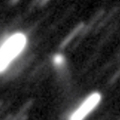
|
It was observed at 15 mag in 2021. Now it is fading. It stays observable at 17 mag for a while in 2022.
Date(TT) R.A. (2000) Decl. Delta r Elong. m1 Best Time(A, h)
Jan. 29 18 15.36 1 9.3 5.703 5.007 41 16.6 5:34 (286, 23)
Feb. 5 18 20.36 2 12.5 5.648 5.020 46 16.6 5:29 (288, 27)
|

|
Now it is 17.7 mag (Jan. 2, J. Drummond). It brightened rapidly. It stays 17 mag for a long time from 2021 to 2022. In the Southern Hemisphere, it stays observable in good condition for a long time. In the Northern Hemisphere, it will be observable only in extremely low sky from autumn to winter.
Date(TT) R.A. (2000) Decl. Delta r Elong. m1 Best Time(A, h)
Jan. 29 7 48.51 -47 0.4 4.889 5.362 113 16.7 23:13 ( 0, 8)
Feb. 5 7 38.08 -47 13.3 4.902 5.368 113 16.7 22:35 ( 0, 8)
|
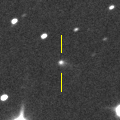
|
Now it is 16.7 mag (Jan. 8, Toshihiko Ikemura, Hirohisa Sato). It will brighten up to 14 mag in early 2023. It stays observable in good condition until spring.
Date(TT) R.A. (2000) Decl. Delta r Elong. m1 Best Time(A, h)
Jan. 29 4 18.09 5 6.1 4.307 4.790 113 16.8 19:44 ( 0, 60)
Feb. 5 4 18.18 5 41.3 4.363 4.748 107 16.8 19:17 ( 0, 61)
|
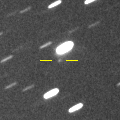
|
Now it is 16.9 mag (Jan. 2, J. Drummond). It is observable at 16.5 mag in good condition from winter to spring.
Date(TT) R.A. (2000) Decl. Delta r Elong. m1 Best Time(A, h)
Jan. 29 10 21.28 -26 54.5 1.616 2.366 129 16.9 1:50 ( 0, 28)
Feb. 5 10 21.30 -25 37.1 1.565 2.368 135 16.8 1:23 ( 0, 29)
|
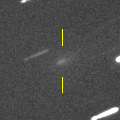
|
First return of a new periodic comet which brightened up to 17 mag in 2011. Now it is 18.2 mag (Jan. 8, Toshihiko Ikemura, Hirohisa Sato). It brightened up to 16.8 mag in October (Oct. 10, Ken-ichi Kadota), however, it has been fading after that.
Date(TT) R.A. (2000) Decl. Delta r Elong. m1 Best Time(A, h)
Jan. 29 14 37.55 -10 55.7 1.355 1.652 88 16.8 5:34 (349, 43)
Feb. 5 14 50.04 -11 57.8 1.317 1.675 92 16.8 5:29 (353, 43)
|

|
Now it is 16.9 mag (Jan. 8, Toshihiko Ikemura, Hirohisa Sato). Fading slowly. In the Northern Hemisphere, it stays observable in good condition for a long time. In the Southern Hemisphere, it is not observable after this.
Date(TT) R.A. (2000) Decl. Delta r Elong. m1 Best Time(A, h)
Jan. 29 19 3.87 49 43.2 9.286 9.020 71 16.8 5:34 (230, 35)
Feb. 5 19 7.42 50 24.1 9.285 9.029 72 16.9 5:29 (230, 39)
|
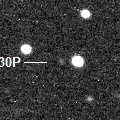
|
Now it is 18.7 mag (Jan. 1, W. Hasubick). It was expected to brighten up to 16.5-17 mag in winter. In its last apparition in 2015, it brightened up to 13 mag. But actually, it is fainter than this ephemeris recently.
Date(TT) R.A. (2000) Decl. Delta r Elong. m1 Best Time(A, h)
Jan. 29 0 25.21 -10 32.6 2.023 1.646 53 16.9 18:52 ( 52, 28)
Feb. 5 0 41.78 -8 11.0 2.046 1.626 51 16.9 18:58 ( 57, 27)
|
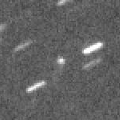
|
Now it is 16.6 mag (Dec. 27, Ken-ichi Kadota). It started fading before the perihelion passage. It was predicted to stay at 16 mag for a long time, but actually, it will be fainter than 18 mag in autumn. In the Northern Hemisphere, it stays observable in good condition for a long time. In the Southern Hemisphere, it is not observable until 2023.
Date(TT) R.A. (2000) Decl. Delta r Elong. m1 Best Time(A, h)
Jan. 29 22 48.14 82 49.6 3.512 3.838 101 16.9 18:52 (172, 37)
Feb. 5 23 0.31 81 2.2 3.561 3.825 98 16.9 18:58 (169, 37)
|
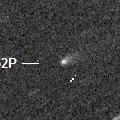
|
Now it is 16.7 mag (Dec. 29, Ken-ichi Kadota). It stays observable at 17 mag from autumn to winter.
Date(TT) R.A. (2000) Decl. Delta r Elong. m1 Best Time(A, h)
Jan. 29 12 53.53 -9 16.9 1.483 2.074 112 16.9 4:22 ( 0, 46)
Feb. 5 12 55.07 -10 18.7 1.442 2.106 119 17.0 3:56 ( 0, 45)
|
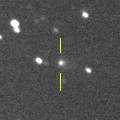
|
Now it is 16.7 mag (Jan. 7, Toshihiko Ikemura, Hirohisa Sato). It continued brightening for a while even after the perihelion passage. It stays observable at 16-17 mag in good condition for a while.
Date(TT) R.A. (2000) Decl. Delta r Elong. m1 Best Time(A, h)
Jan. 29 4 22.06 -9 33.6 3.550 3.989 109 17.0 19:48 ( 0, 46)
Feb. 5 4 22.51 -8 23.5 3.653 4.008 104 17.1 19:21 ( 0, 47)
|
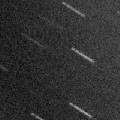
|
It has not been observed yet in this return. It was predicted to brighten up to 16.5 mag in January. It will fade out rapidly after this.
Date(TT) R.A. (2000) Decl. Delta r Elong. m1 Best Time(A, h)
Jan. 29 23 43.98 -2 31.4 1.629 1.191 46 17.1 18:52 ( 66, 27)
Feb. 5 0 7.94 1 40.6 1.658 1.215 46 17.5 18:58 ( 72, 27)
|
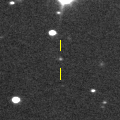
|
Now it is 17.4 mag (Jan. 7, Toshihiko Ikemura, Hirohisa Sato). It will brighten up to 11.5 mag in 2022 winter. It stays observable while the comet will be brightening slowly.
Date(TT) R.A. (2000) Decl. Delta r Elong. m1 Best Time(A, h)
Jan. 29 2 59.33 13 28.4 2.829 3.116 97 17.2 18:52 ( 17, 68)
Feb. 5 3 1.97 13 48.4 2.895 3.078 91 17.1 18:58 ( 35, 65)
|
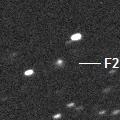
|
Now it is 17.2 mag (Jan. 7, Toshihiko Ikemura, Hirohisa Sato). It stays observable at 17-18 mag for a long time until 2024.
Date(TT) R.A. (2000) Decl. Delta r Elong. m1 Best Time(A, h)
Jan. 29 14 37.73 -4 26.8 8.811 8.871 90 17.2 5:34 (347, 50)
Feb. 5 14 36.48 -4 5.7 8.681 8.867 97 17.1 5:29 (357, 51)
|
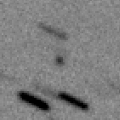
|
Now it is 17.6 mag (Jan. 1, J.-G. Bosch, F. Kugel, J. Nicolas). It is observable at 17 mag from November to March. It is observable in good condition in the Northern Hemisphere, but it locates low in the Southern Hemisphere.
Date(TT) R.A. (2000) Decl. Delta r Elong. m1 Best Time(A, h)
Jan. 29 5 19.46 29 52.6 1.735 2.504 132 17.2 20:45 ( 0, 85)
Feb. 5 5 19.62 30 23.1 1.794 2.495 125 17.2 20:18 ( 0, 85)
|

|
It has not been observed yet in this apparition. It was expected to be observable at 16 mag in good condition in spring. But actually, it is fainter than 19.2 mag (Jan. 22, John Drummond).
Date(TT) R.A. (2000) Decl. Delta r Elong. m1 Best Time(A, h)
Jan. 29 15 34.37 -33 12.9 1.606 1.571 70 17.5 5:34 (341, 19)
Feb. 5 16 0.03 -34 1.7 1.538 1.542 71 17.3 5:29 (340, 18)
|
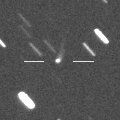
|
Now it is 16.4 mag (Oct. 4, ATLAS-MLO, Mauna Loa). In the Southern Hemisphere, it stays observable for a long time. In the Northern Hemisphere, it is not observable after this.
Date(TT) R.A. (2000) Decl. Delta r Elong. m1 Best Time(A, h)
Jan. 29 11 15.15 -54 24.2 3.591 3.896 100 17.3 2:44 ( 0, 0)
Feb. 5 11 3.41 -53 46.7 3.554 3.945 106 17.3 2:05 ( 0, 1)
|
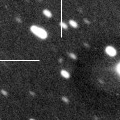
|
Now it is 17.4 mag (Jan. 2, J. Drummond). It will brighten up to 13-14 mag from 2024 to 2025.
Date(TT) R.A. (2000) Decl. Delta r Elong. m1 Best Time(A, h)
Jan. 29 7 19.50 -31 46.1 7.911 8.529 126 17.3 22:44 ( 0, 23)
Feb. 5 7 17.07 -31 33.7 7.890 8.491 124 17.3 22:15 ( 0, 23)
|
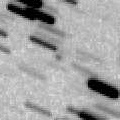
|
Now it is 17.8 mag (Jan. 2, Ken-ichi Kadota). It is expected to brighten up to 13.5 mag from June to July. It is observable only in the Southern Hemisphere at the high light. In the Northern Hemisphere, it is observable only until March when it brightens up to 16.5 mag.
Date(TT) R.A. (2000) Decl. Delta r Elong. m1 Best Time(A, h)
Jan. 29 1 9.71 7 27.2 2.381 2.247 70 17.4 18:52 ( 57, 48)
Feb. 5 1 10.67 5 38.6 2.441 2.171 62 17.3 18:58 ( 63, 41)
|
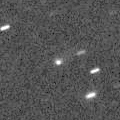
|
Now it is 17.3 mag (Jan. 7, Toshihiko Ikemura, Hirohisa Sato). It will be observable at 17 mag in good condition in spring.
Date(TT) R.A. (2000) Decl. Delta r Elong. m1 Best Time(A, h)
Jan. 29 13 41.73 -9 26.1 4.414 4.714 101 17.4 5:10 ( 0, 45)
Feb. 5 13 43.15 -9 36.4 4.307 4.713 108 17.3 4:44 ( 0, 45)
|

|
Now it is 18.2 mag (Jan. 28, Ken-ichi Kadota). It is expected to brighten up to 11 mag from summer to autumn. It stays observable in good condition in the Southern Hemisphere. In the Northern Hemisphere, it becomes extremely low from August to September.
Date(TT) R.A. (2000) Decl. Delta r Elong. m1 Best Time(A, h)
Jan. 29 11 4.55 24 11.3 1.694 2.576 146 17.6 2:34 ( 0, 79)
Feb. 5 10 59.92 25 25.9 1.601 2.521 153 17.3 2:01 ( 0, 80)
|

|
Now it is 17.8 mag (Jan. 8, Toshihiko Ikemura, Hirohisa Sato). It stays 17-18 mag for a long time from 2021 to 2022. It is observable in excellent condition in the Northern Hemisphere, It locates somewhat low in the Southern Hemisphere.
Date(TT) R.A. (2000) Decl. Delta r Elong. m1 Best Time(A, h)
Jan. 29 2 48.03 28 42.5 5.131 5.378 99 17.4 18:52 ( 55, 80)
Feb. 5 2 44.25 28 12.8 5.259 5.374 91 17.4 18:58 ( 72, 73)
|
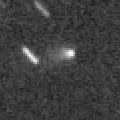
|
Now it is 17.1 mag (Jan. 14, Thomas Lehmann). It was expected to brighten up to 15.5 mag in winter. But actually, it is fading even before the perihelion passage. In the Northern Hemisphere, it stays observable in good condition for a long time. It is not observable at all in the Southern Hemisphere.
Date(TT) R.A. (2000) Decl. Delta r Elong. m1 Best Time(A, h)
Jan. 29 16 43.20 82 9.6 2.548 2.947 104 17.5 5:34 (187, 41)
Feb. 5 16 25.61 85 43.1 2.537 2.946 104 17.5 5:29 (183, 39)
|

|
Now it is 17.7 mag (Jan. 1, Toshihiko Ikemura, Hirohisa Sato). In the Northern Hemisphere, it stays observable for a long time while it is getting fainter slowly. In the Southern Hemisphere, it will never be observable again.
Date(TT) R.A. (2000) Decl. Delta r Elong. m1 Best Time(A, h)
Jan. 29 14 54.29 43 2.4 7.407 7.649 100 17.5 5:34 (226, 78)
Feb. 5 14 53.86 43 34.2 7.390 7.696 104 17.5 5:29 (208, 80)
|
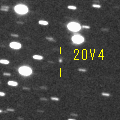
|
Now it is 17.5 mag (Jan. 3, Toshihiko Ikemura, Hirohisa Sato). It is observable at 17.5 mag in good condition in winter.
Date(TT) R.A. (2000) Decl. Delta r Elong. m1 Best Time(A, h)
Jan. 29 7 47.72 3 31.7 4.307 5.242 159 17.5 23:13 ( 0, 58)
Feb. 5 7 44.92 3 47.8 4.339 5.249 155 17.6 22:43 ( 0, 59)
|
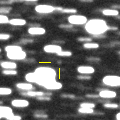
|
Now it is 17.7 mag (Jan. 7, Toshihiko Ikemura, Hirohisa Sato). It will brighten up to 15-16 mag in 2023.
Date(TT) R.A. (2000) Decl. Delta r Elong. m1 Best Time(A, h)
Jan. 29 7 18.88 -24 2.8 4.710 5.429 132 17.6 22:43 ( 0, 31)
Feb. 5 7 9.82 -23 31.2 4.693 5.383 130 17.6 22:07 ( 0, 31)
|
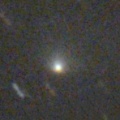
|
It brightened up to 14.5 mag in autumn (Oct. 1, Ken-ichi Kadota). Now it is fading. It has already faded down to 16.4 mag (Jan. 1, Toshihiko Ikemura, Hirohisa Sato). It will be fading rapidly after this. It will be fainter than 18 mag in February.
Date(TT) R.A. (2000) Decl. Delta r Elong. m1 Best Time(A, h)
Jan. 29 0 49.00 -5 7.8 2.807 2.482 60 17.6 18:52 ( 51, 36)
Feb. 5 0 59.90 -3 52.0 2.898 2.500 56 17.8 18:58 ( 57, 33)
|
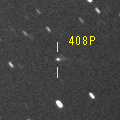
|
It brightened very rapidly. Now it is 17.8 mag (Jan. 3, Purple Mountain Observatory, XuYi Station). It will brighten up to 16 mag, and it will be observable in good condition in 2022 winter.
Date(TT) R.A. (2000) Decl. Delta r Elong. m1 Best Time(A, h)
Jan. 29 0 9.32 -0 37.8 4.165 3.660 53 17.7 18:52 ( 63, 32)
Feb. 5 0 16.69 -0 8.2 4.236 3.650 47 17.7 18:58 ( 69, 28)
|
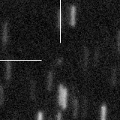
|
Now it is 17.5 mag (Jan. 1, H. Nohara). It is expected to brighten up to 12 mag from winter to summer in 2023. In the Northern Hemisphere, it stays observable in good condition until 2023 spring. In the Southern Hemisphere, it is not observable until summer.
Date(TT) R.A. (2000) Decl. Delta r Elong. m1 Best Time(A, h)
Jan. 29 1 30.38 49 58.4 5.108 5.244 92 17.7 18:52 (135, 64)
Feb. 5 1 34.44 48 51.8 5.146 5.185 86 17.7 18:58 (129, 60)
|
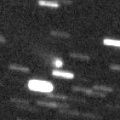
|
It was observed at 16 mag from 2020 to 2021. Now it is fading. It will be fainter than 18 mag in spring.
Date(TT) R.A. (2000) Decl. Delta r Elong. m1 Best Time(A, h)
Jan. 29 15 42.06 -36 0.8 6.115 5.820 68 17.7 5:34 (340, 15)
Feb. 5 15 41.07 -36 45.9 6.030 5.852 74 17.7 5:29 (345, 16)
|
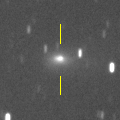
|
It brightened even after the perihelion passage, and it brightened up to 13.5 mag in December (Dec. 6, Katsumi Yoshimoto). Now it is fading. But it is still bright as 16.3 mag (Jan. 24, Charles S. Morris). It is observable in excellent condition in the Northern Hemisphere. It locates low in the Southern Hemisphere.
Date(TT) R.A. (2000) Decl. Delta r Elong. m1 Best Time(A, h)
Jan. 29 6 41.08 40 34.3 1.250 2.134 145 17.7 22:07 (180, 84)
Feb. 5 6 39.64 40 10.2 1.330 2.173 138 18.0 21:38 (180, 85)
|
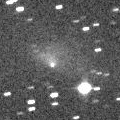
|
It brightened up to 10.1 mag in spring (Apr. 10, Marco Goiato). Now it is fading. It has already faded down to 16.5 mag (Dec. 30, Ken-ichi Kadota). It stays observable in good condition for a long time after this while the comet will fading.
Date(TT) R.A. (2000) Decl. Delta r Elong. m1 Best Time(A, h)
Jan. 29 3 45.72 9 53.5 2.558 3.004 107 17.8 19:12 ( 0, 65)
Feb. 5 3 48.30 10 36.8 2.692 3.042 101 18.0 18:58 ( 6, 66)
|

|
First return of a new periodic comet which brightened up to 16.5 mag in 1997. Now it is 19.4 mag (Jan. 11, Purple Mountain Observatory, XuYi Station). It is fainter than originally predicted by 2 mag. It is observable in good condition from January to March.
Date(TT) R.A. (2000) Decl. Delta r Elong. m1 Best Time(A, h)
Jan. 29 8 39.82 27 18.9 1.171 2.149 170 19.7 0:09 ( 0, 82)
Feb. 5 8 34.87 26 31.2 1.158 2.129 166 19.6 23:32 ( 0, 81)
|
|
![]()
 C/2019 T2 ( Lemmon )
C/2019 T2 ( Lemmon ) C/2021 G2 ( ATLAS )
C/2021 G2 ( ATLAS ) C/2021 T2 ( Fuls )
C/2021 T2 ( Fuls ) 99P/Kowal 1
99P/Kowal 1 73P/Schwassmann-Wachmann 3
73P/Schwassmann-Wachmann 3 C/2020 U4 ( PanSTARRS )
C/2020 U4 ( PanSTARRS ) C/2021 D2 ( ZTF )
C/2021 D2 ( ZTF ) C/2018 N2 ( ASASSN )
C/2018 N2 ( ASASSN ) P/2020 V4 ( Rankin )
P/2020 V4 ( Rankin ) A/2021 X1
A/2021 X1 284P/McNaught
284P/McNaught 408P/2020 M7 ( Novichonok-Gerke )
408P/2020 M7 ( Novichonok-Gerke ) C/2021 Y1 ( ATLAS )
C/2021 Y1 ( ATLAS ) C/2017 Y2 ( PanSTARRS )
C/2017 Y2 ( PanSTARRS ) 108P/Ciffreo
108P/Ciffreo 10P/Tempel 2
10P/Tempel 2 440P/2021 W2 ( Kobayashi )
440P/2021 W2 ( Kobayashi )![]()


































































